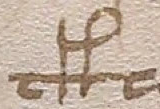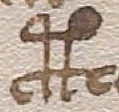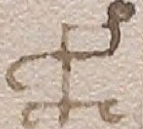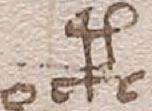Holding Hands
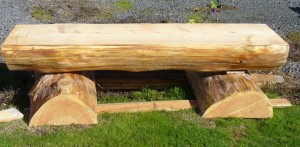
intrinsically Bench courtesy of Creation Woods.
Bogotol 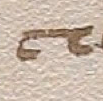 There’s a character in the VMS sometimes refered to as the “bench” character. It may seem odd to us, but in medieval documents, this is quite a common ligature, sometimes representing “ce”, sometimes “cr”, sometimes “er”. It depends on the language and the context. It was written as one character to follow the flow of the hand. It also somewhat resembles the Greek letter Pi (although it’s a bit curvier).
There’s a character in the VMS sometimes refered to as the “bench” character. It may seem odd to us, but in medieval documents, this is quite a common ligature, sometimes representing “ce”, sometimes “cr”, sometimes “er”. It depends on the language and the context. It was written as one character to follow the flow of the hand. It also somewhat resembles the Greek letter Pi (although it’s a bit curvier).
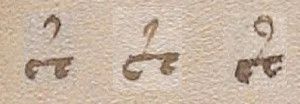 No one is certain what it represents in the Voynich manuscript and it’s not entirely clear if it’s a ligature or a character on its own. Sometimes it is plain (as shown above) and sometimes it has a cap (see right). The shape and position of the cap varies quite a bit but the bench underneath tends to behave in fairly consistent ways, ways that are similar to the plain bench.
No one is certain what it represents in the Voynich manuscript and it’s not entirely clear if it’s a ligature or a character on its own. Sometimes it is plain (as shown above) and sometimes it has a cap (see right). The shape and position of the cap varies quite a bit but the bench underneath tends to behave in fairly consistent ways, ways that are similar to the plain bench.
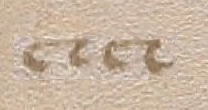 The bench is a common character. It’s found throughout the manuscript, often multiple times per line, and it is frequently at the beginning of glyph groups. Benches don’t usually sit next to each other, but there are exceptions (right).
The bench is a common character. It’s found throughout the manuscript, often multiple times per line, and it is frequently at the beginning of glyph groups. Benches don’t usually sit next to each other, but there are exceptions (right).
Friends on the Bench
 The bench glyph has an interesting property that distinguishes it from other shapes. Sometimes it stretches over other characters that are tall, with straight stems, commonly known as “gallows” characters. This creates a combination shape (or perhaps a ligature or a shape with an entirely different meaning).
The bench glyph has an interesting property that distinguishes it from other shapes. Sometimes it stretches over other characters that are tall, with straight stems, commonly known as “gallows” characters. This creates a combination shape (or perhaps a ligature or a shape with an entirely different meaning).
 Sometimes the connection between the left and right sides of the bench is broken and appears to have been intentionally written this way (rather than it being a slip of the pen). There are numerous examples of separated bench characters, but the majority are joined, so it’s difficult to tell whether it’s meant to represent one character or two (or something else). The disconnect happens with both plain and cap benches.
Sometimes the connection between the left and right sides of the bench is broken and appears to have been intentionally written this way (rather than it being a slip of the pen). There are numerous examples of separated bench characters, but the majority are joined, so it’s difficult to tell whether it’s meant to represent one character or two (or something else). The disconnect happens with both plain and cap benches.
Apparently, the bench can cross any gallows character, although some combinations are less common than others—a bench crossing a one-loop “P” is quite rare.
Sometimes glyph combinations that look similar differ in whether the bench character has a cap.
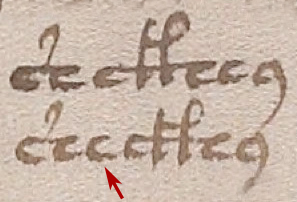 In some parts of the manuscript (e.g., some of the plant sections), it’s uncommon to see a bench and a gallows-bench next to each other. In other parts, like the bathing nymph sections it’s not uncommon. It was suggested by Capt. Prescott H. Currier that there may be two “languages” (two different glyph-combination systems) underlying the VMS. These have been named Currier A and Currier B.
In some parts of the manuscript (e.g., some of the plant sections), it’s uncommon to see a bench and a gallows-bench next to each other. In other parts, like the bathing nymph sections it’s not uncommon. It was suggested by Capt. Prescott H. Currier that there may be two “languages” (two different glyph-combination systems) underlying the VMS. These have been named Currier A and Currier B.
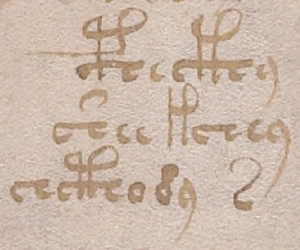 You can see how frequently benches are used in the example on the left from one of the plant pages. In this small selection of text, there are three gallows benches, two plain benches and a cap bench. Note how several of the bench characters are followed by small c-shaped glyphs. This is a common pattern. Note also that the P-bench and the gallows-bench following it are not usually combined this close together, in the same “word” token.
You can see how frequently benches are used in the example on the left from one of the plant pages. In this small selection of text, there are three gallows benches, two plain benches and a cap bench. Note how several of the bench characters are followed by small c-shaped glyphs. This is a common pattern. Note also that the P-bench and the gallows-bench following it are not usually combined this close together, in the same “word” token.
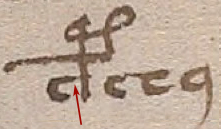 There’s a curious half-bench that appears in some of the combination glyphs. Sometimes the scribe drew only the left or right side of the bench, but it does appear to be distinct from the curved “c” shape in that the top is longer and straighter than the VMS “c” (sometimes even longer and straighter than this example on the right).
There’s a curious half-bench that appears in some of the combination glyphs. Sometimes the scribe drew only the left or right side of the bench, but it does appear to be distinct from the curved “c” shape in that the top is longer and straighter than the VMS “c” (sometimes even longer and straighter than this example on the right).
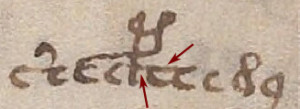 Sometimes the half-bench stretches across a gallows character and attaches itself to another bench on the other side (or perhaps it’s a full bench followed by a half-bench—there’s no way to tell). This long string of cap and plain benches is not common.
Sometimes the half-bench stretches across a gallows character and attaches itself to another bench on the other side (or perhaps it’s a full bench followed by a half-bench—there’s no way to tell). This long string of cap and plain benches is not common.
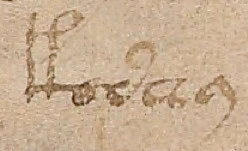 There are many bench characters on Folio 1r, including gallows benches, and near the bottom is this character (right) with only the right side of a bench. This half-bench is attached to a cap bench and then what may be another half bench. You have to examine it carefully to try to puzzle out which parts belong to which because the line attaching the two parts of the cap bench is very faint.
There are many bench characters on Folio 1r, including gallows benches, and near the bottom is this character (right) with only the right side of a bench. This half-bench is attached to a cap bench and then what may be another half bench. You have to examine it carefully to try to puzzle out which parts belong to which because the line attaching the two parts of the cap bench is very faint.
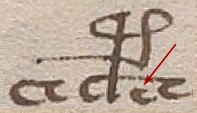 I wrote earlier that a bench can only cross a gallows character, and this is generally true, but there are a few rare instances in which a small glyph is inserted under the bench. It looks as though this is intentional since the leg of the gallows character is shifted to the left to make room.
I wrote earlier that a bench can only cross a gallows character, and this is generally true, but there are a few rare instances in which a small glyph is inserted under the bench. It looks as though this is intentional since the leg of the gallows character is shifted to the left to make room.
 To the right are examples of plain benches followed directly by gallows benches. The glyph combinations of the two words are very similar except for the additional glyph in the character group on the right. This form of repetition, where the following word differs from the previous by only one character (either by changing a character, or by adding or subtracting one) happens frequently in the VMS and is one of the reasons people have questioned whether there is sense or nonsense underlying the unusual glyphs.
To the right are examples of plain benches followed directly by gallows benches. The glyph combinations of the two words are very similar except for the additional glyph in the character group on the right. This form of repetition, where the following word differs from the previous by only one character (either by changing a character, or by adding or subtracting one) happens frequently in the VMS and is one of the reasons people have questioned whether there is sense or nonsense underlying the unusual glyphs.
Are There Other Bench Oddities?
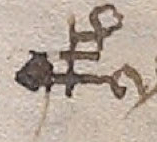 There is a very different bench (right), in the naked nymphs section, that stands out as fractured, globby, and unconventional. There are anomalies in the VMS that suggest someone may have tampered with several parts of the manuscript, so it’s possible this bench-gallows, which is at the end of a line, was added by someone else and may not mean anything at all.
There is a very different bench (right), in the naked nymphs section, that stands out as fractured, globby, and unconventional. There are anomalies in the VMS that suggest someone may have tampered with several parts of the manuscript, so it’s possible this bench-gallows, which is at the end of a line, was added by someone else and may not mean anything at all.
Convenient to Write or a Different Character?
Is the bench character a ligature, a combination character, or a convenient way to write a sequence with less movement of the hand?
 I found this intriguing example on the right that has a plain bench on either side of the gallows but does not cross the gallows. If it’s intentional that there are two separate benches enclosing the gallows-P without crossing it (and not misdirection or a lapse of habit) then it might suggest that the stretched bench represents something other than a quick way to write a gallows with a bench on either side.
I found this intriguing example on the right that has a plain bench on either side of the gallows but does not cross the gallows. If it’s intentional that there are two separate benches enclosing the gallows-P without crossing it (and not misdirection or a lapse of habit) then it might suggest that the stretched bench represents something other than a quick way to write a gallows with a bench on either side.
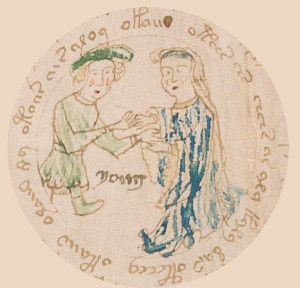 One of the difficulties in trying to crack the Voynich code is determining how much meaning might be attached to each shape. If you’re not sure whether a shape represents one, two, three, or more characters (or concepts), then creating algorithms in your mind or on a computer entails a lot more trial and error.
One of the difficulties in trying to crack the Voynich code is determining how much meaning might be attached to each shape. If you’re not sure whether a shape represents one, two, three, or more characters (or concepts), then creating algorithms in your mind or on a computer entails a lot more trial and error.
I’ll leave you to ponder that example and decide whether the dynamics of the bench character can help us better understand the VMS “alphabet”.
J.K. Petersen
© Copyright 2016 J.K. Petersen, All Rights Reserved

